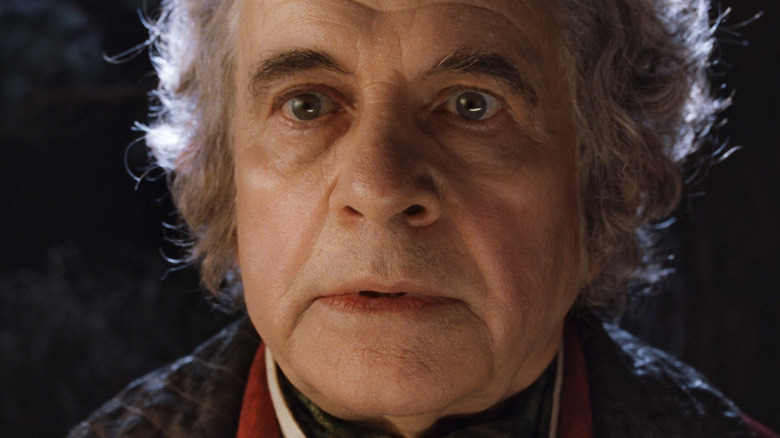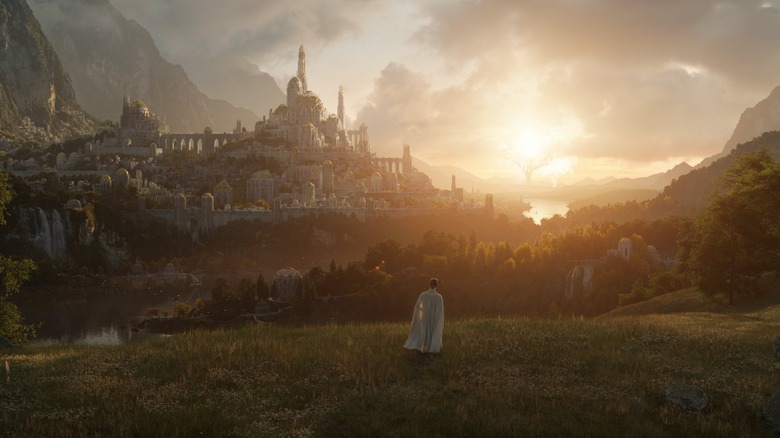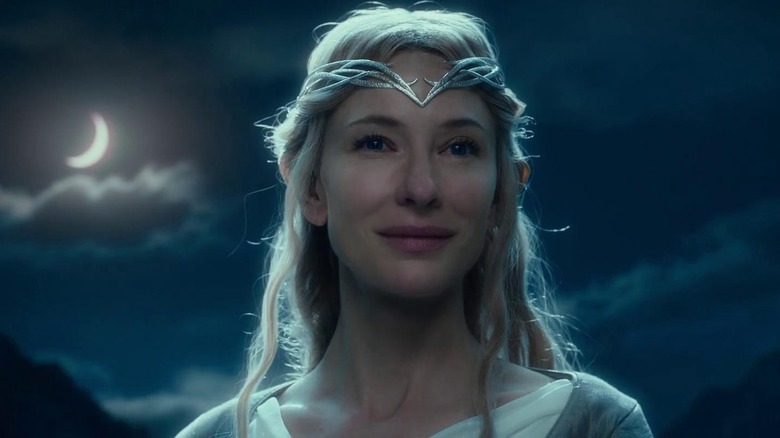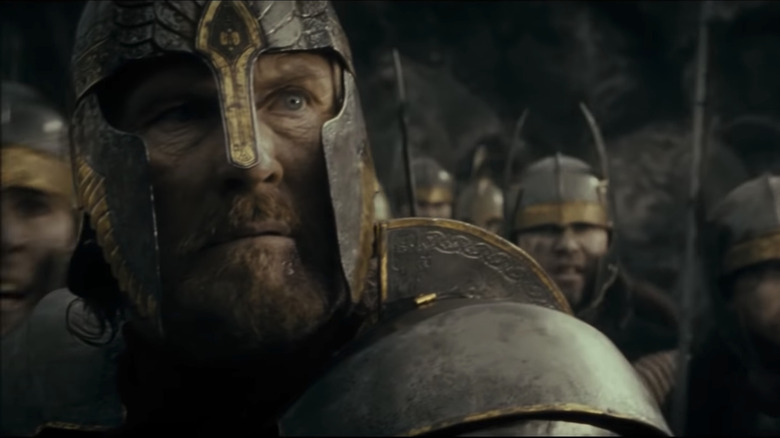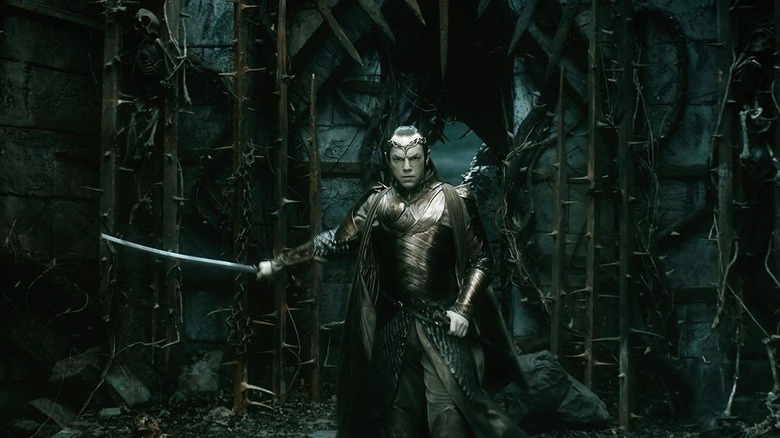How Will Amazon Prime Handle Its Middle-Earth Timeline?
These days there are a lot of companies tackling ambitious film projects. More and more of these are taking place over extended periods of time, too — both in-story and on-set. Sometimes, this is due to the unique demands of resurrecting an older franchise, like "Indiana Jones" or "Rocky." At other times, the timeline challenge is inherently woven into the story itself. Apple's sprawling "Foundation" series is a great example of this predicament. The show was literally approved after a single-sentence pitch that started out with "It's a 1,000-year chess game between Hari Seldon and the Empire." In the first season alone, we've already seen time jumps that span decades.
Of course, "Foundation" is a bit of an exception to the rule at the moment. Even when the timeline is extended, most shows don't have to tackle millennia-spanning stories. But there's one company, in particular, that has gone even further than Apple TV+'s Asimovian adventure. After acquiring the rights to a portion of Tolkien's Middle-earth works back in 2017, Amazon Studios brazenly announced that it planned to tell a story that takes place during the Second Age of that world, an era never before explored on screens, and only barely explored in prose, for that matter. That sounds nice and simple — until one considers the fact that the Second Age of Middle-earth plays out for well over 3,000 years. There are pockets of isolated stories within that time period, but by and large, the narrative tends to flow uninterrupted from one end of the age to the other.
This begs the question: How will Amazon handle the timeline throughout its multi-season show? While only time will truly tell, we've decided to break down some of the options based on the announcements, leaks, and rumors that we have so far.
Sorting fact from fiction
Amazon's show has been incubating for a long time, and over that period there has been plenty of time for leaks and rumors to abound. Some of these have been initiated (or at least confirmed) by the studio. Others remain grist for the rumor mill.
Taken as a whole, the information that we've gotten thus far continues to send mixed signals about what part of the age the show will focus on. The official synopsis references a "time of relative peace" and characters confronting "the long-feared re-emergence of evil to Middle-earth." These statements seem to indicate a beginning set earlier in the Second Age, before Sauron emerges as the big baddy of Middle-earth. In August of 2021, the studio also released a first look image that pretty blatantly hints at a portion of the show taking place even earlier, all the way back before the First Age.
At the same time, a leak in July of 2021 shared by the high-profile fan site TheOneRing.net (which claims to have verified most of the information) suggests that Sauron won't be in the first season of the show at all. Once again, this could indicate a slow start early in the age, although there are other points later on in the timeline that would make sense, as well.
Then, in October of 2021, another fan group called the Fellowship of the Fans tossed a grenade into the mix by claiming that it had exclusive information that, if true, would massively impact the timing of the show. The leak said that one of the main characters in the first season would be Isildur — a Man who isn't even born until 3,209 years into the Second Age. With so many conflicting rumors flying around, the timeline of Amazon's show remains absolutely befuddling.
Amazon could just start at the beginning
With so many rumors sprawling across millennia, the only constant right now is chaos. But that's where fans thrive, isn't it? Let's follow the breadcrumbs and break down some of the ways Amazon could set up its Middle-earth timeline in a manner that everyone can actually follow.
The first and most straightforward option would be for the show to start at the beginning of the story. This would allow the production crew to establish characters, locations, and other important facts and then build on them moving forward. They could introduce anchor characters like Galadriel and Elrond, who are present from the beginning, and use them as a sort of "story infrastructure" to provide consistency as other characters come and go.
Of course, even starting "at the beginning" of the Second Age presents some time-related issues. For one thing, the source material stretches back tens of thousands of years before the Second Age. And while that age does represent a bit of a "hard reset" in Middle-earth history, it would be hard to dive in and tell a chronological story from Year One of the Second Age without providing a heck of a lot of exposition about what happened before that time.
Another issue that comes with starting at the beginning is how to pace the story. Remember, we're working with immortal Elves and other spirits here. Decades and even centuries can go by without any real change to their lives. In fact, what can arguably be called the single biggest event of the era — Sauron forging the One Ring — doesn't happen until 1,600 years into the age. And then he doesn't lose it until another 1,800 years later. The time gaps here are enormous — and could present a serious issue if Amazon tries to strictly work through the story in order.
Amazon could start at the end and work backward
If telling the story from the beginning is too difficult as far as pacing is concerned, another option is to start at the end and work backward. This is pretty much the polar opposite of a forward-moving chronological story, as it would start with the cataclysmic events that end the age and then look backward for exposition to fill in the gaps.
The nice thing about this approach is that it would significantly shorten the narrative time span that we're talking about here. For instance, the big story that takes place at the end of the Second Age has to do with the island nation of Númenor. This is the nation of Men that eventually founds the kingdom of Gondor. Its kings are also the direct ancestors of Aragorn, giving him his claim to the kingship in "The Lord of the Rings." While Númenor is around for the entire Second Age, its big spotlight moment comes in the last two centuries of that era. This is a much smaller window of time to work within.
If Amazon chose to tell the story by starting at the end like this, though, it would require a lot of backward glances as we go along. We'd need to fill in countless details as we run into various Elves, Men, Dwarves, Halflings, and countless villains. It could get a bit overwhelming, but it seems like a logical possibility as a way to pair down the story and focus on a single, compelling narrative.
Amazon could skip around from one place to the next
While there are definitely themes that run throughout the Second Age, there are plenty of pockets of isolated events that the show could focus on from one season — or even one episode — to the next. This anthology format would allow Amazon to jump around in time and focus on individual, self-contained tales. This approach honestly makes the most narrative sense, but it also seems somewhat unlikely given the industry preference for serialized stories.
The show could spend some time following the Elves on the mainland before shifting out to see what's happening with the Men of Númenor. From there, they could pay the then-prosperous halls of Khazad-dûm a visit before heading southwest to watch Sauron set up his new kingdom of Mordor.
The possibilities are endless, but it's hard to ignore the fact that the idea of skipping around from one spot to the next could quickly become disjointed and overwhelming. Sure, it would give us lots of cool snapshots into different areas of Middle-earth history, but it would almost certainly struggle to offer a compelling central story. If we had to make a guess, chances are the studio will find some kind of chronological approach.
Whichever way the studio chooses to go, though, one thing is clear: Amazon has its work cut out for it when it comes to creating a coherent timeline that viewers will be able to follow.
